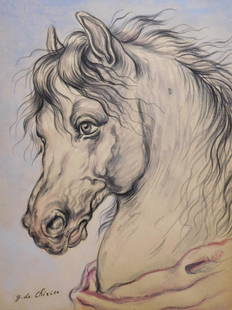

 Discovery- InteriorsBonhamsSponsored.Your ad here?
Discovery- InteriorsBonhamsSponsored.Your ad here?



Discovery- Interiors
Bonhams
Sponsored.Your ad here?


 Discovery- InteriorsBonhamsSponsored.Your ad here?
Discovery- InteriorsBonhamsSponsored.Your ad here?



Discovery- Interiors
Bonhams
Sponsored.Your ad here?

Giorgio de Chirico Italian (1888-1978)
Similar Sale History
View More Items in PaintingsRelated Paintings
More Items in Paintings
View MoreRecommended Art
View More








Item Details
Description
Attributes: Signed on the lower right. After Giorgio de Chirico - Media: Graphite on paper - Condition: Fair condition, perforations throughout - Provenance: Private collection, South America - Dimensions (cm): 27.2 by 17.4 - Dimensions (inches): 10.7 by 6.9 - Biography: Giorgio De Chirico (Italian, July 10, 1888-November 20, 1978) was a notable Surrealist painter and graphic artist who founded the Metaphysical Art movement. He was born in Volos, a coastal city of Thessaly, and was encouraged by his father from a young age to cultivate a passion for art. In 1906, De Chirico enrolled in the Academy of Fine Arts in Munich. Once he moved to Germany, De Chirico exposed himself to the latest philosophical, literary, and artistic culture. He read authors such as Arthur Schopenhauer, Otto Weininger, and Friedrich Nietzsche while also studying the art of Arnold Bocklin (Swiss, 1827-1901) and Max Klinger (German, 1857-1920). These influences helped De Chirico develop his style after he moved back to Italy in 1908, where he created the first painting associated with the Metaphysical Art Movement: Enigma of an Autumn Afternoon. In July 1911, De Chirico traveled to Paris, where his artistic career blossomed. He was able to gain a connection, through his brother, with Pierre Laprande, a jury member at the Salon d'Automne. During this time, he exhibited three works at the Salon d'Automne: Enigma of an Afternoon, Self Portrait, and Enigma of the Oracle, which even gained the interest of Pablo Picasso (Spanish, 1881-1973). De Chirico's fame stemmed from the Surrealist qualities inherent in his works. The cityscapes were treated not as bustling urban areas, but as the eerily empty scenes encountered in dreams, with the potential of symbolic meaning. De Chirico also favored the depiction of Italian architecture with its broad archways and piazzas. However, he disapproved of the formal innovations of Modern Art and instead opted for a realism that allowed simple, straightforward representation. After the start of the First World War, the artist attempted to enlist in the Italian army but was labeled as "unfit" for work. Instead, he moved to Rome and continued his life as an outspoken painter against Modern Art, eventually writing an article in the magazine Valori Plastici called "The Return of Craftsmanship." The article supports his love of Classicism and the style of the Old Masters such as Raphael (Italian, 1483-1520). In 1929, De Chirico published the novel Hebdòmeros, the Metaphysician. Twenty years later, the artist bought a house with his second wife Isabella Pakszwer Far near the Spanish Steps in Rome, which later became a museum for his works. He managed to remain productive up until the 1970s. He was elected to the French Academie des Beaux-Arts in 1974, and died in Rome on November 20, 1978.
Condition
All lots that do not carry established documented provenance nor any past record of auction history record are described in the catalog as attributed .
All authorship of items in this catalog are described according to the following terms:
Signed [Artist Name] : In cases in which the signature is legible in the lot, this work is described as-is with no attributions given.
By [Artist Name] : The work is by the artist.
Attributed to [Artist Name] : The work may be ascribed to the artist on the basis of style, but there may be some question as to actual authorship.
In the manner of [Artist Name] : The work was executed by an unknown hand, but was designed deliberately to emulate the style of the artist.
After [Artist Name] : The work was executed by an unknown hand, but is a deliberate copy of a known work by the artist.
Circle of [Artist Name] : A work of the period of the artist showing his influence, closely associated with the artist but not necessarily his pupil.
Follower of [Artist Name]: A work by a pupil or a follower of the artist (not necessarily a pupil).
American, 19th century : This work was executed by an unknown hand, and can only be identified by origin (i.e., region, period).
Buyer's Premium
- 15%
Giorgio de Chirico Italian (1888-1978)
Estimate $1,000 - $2,500
1 bidder is watching this item.
Shipping & Pickup Options
Item located in lima, peSee Policy for Shipping
Payment

TOP



































































